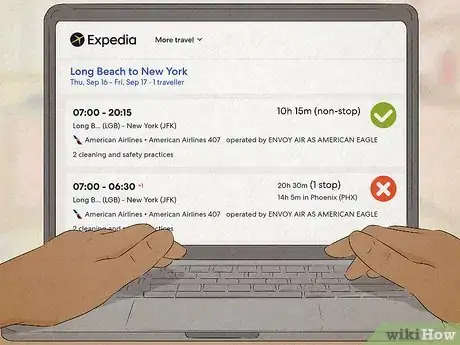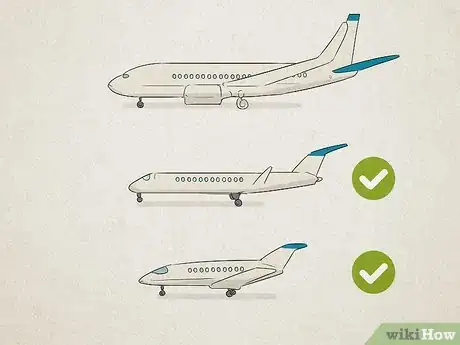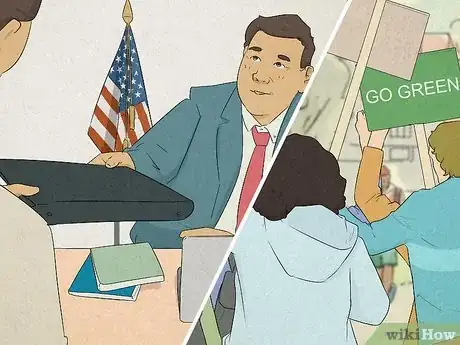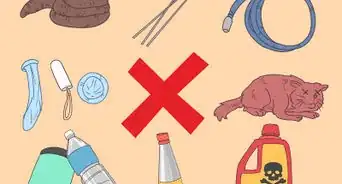This article was co-authored by Carbonfund.org and by wikiHow staff writer, Christopher M. Osborne, PhD. Carbonfund.org is a Carbon Offset and Environmental Education Organization based in New York. Carbonfund.org is leading the fight against climate change, making it easy and affordable for any individual, business, or organization to reduce and offset their climate impact and hasten the transition to a clean energy future. Carbonfund.org achieves its goals through climate change education, carbon offsets and reductions, and public outreach.
There are 16 references cited in this article, which can be found at the bottom of the page.
This article has been viewed 25,663 times.
It's undeniable that the carbon dioxide (CO2) emissions from air travel contribute to climate change, a fact that can easily leave you with flyer's remorse. Fortunately, you have options when it comes to reducing your carbon impact while flying. For example, you can pay for environmentally-friendly “carbon offsets” that help balance out the CO2 emissions from your flight. You can also cut your personal carbon footprint by flying as eco-friendly as possible, and help on a broader level by reducing your daily carbon emissions and advocating for widespread change.
Steps
References
- ↑ https://www.smithsonianmag.com/travel/if-you-travel-and-care-about-environment-you-should-buy-carbon-offsets-180952222/
- ↑ https://www.nytimes.com/2017/07/27/climate/airplane-pollution-global-warming.html
- ↑ https://www.abc.net.au/news/science/2018-04-11/carbon-offsets-worth-buying-air-travel-tourism-emissions/9638466
- ↑ Carbonfund.org. Carbon Offset & Environmental Education Organization. Expert Interview. 18 April 2022.
- ↑ https://www.abc.net.au/news/science/2018-04-11/carbon-offsets-worth-buying-air-travel-tourism-emissions/9638466
- ↑ https://davidsuzuki.org/what-you-can-do/carbon-offsets/
- ↑ Carbonfund.org. Carbon Offset & Environmental Education Organization. Expert Interview. 18 April 2022.
- ↑ https://www.smithsonianmag.com/travel/if-you-travel-and-care-about-environment-you-should-buy-carbon-offsets-180952222/
- ↑ https://theicct.org/blog/staff/fly-like-a-nerd-20191028
- ↑ https://theicct.org/sites/default/files/publications/variation-aviation-emissions-itinerary-jul2021-1.pdf
- ↑ https://theicct.org/
- ↑ https://theicct.org/blog/staff/fly-like-a-nerd-20191028
- ↑ https://flight.nasa.gov/pdf/18_jung_green_aviation_summit.pdf
- ↑ https://davidsuzuki.org/what-you-can-do/air-travel-climate-change/
- ↑ https://theicct.org/sites/default/files/publications/variation-aviation-emissions-itinerary-jul2021-1.pdf
- ↑ https://theicct.org/sites/default/files/publications/Transborder-airline-ranking_working-paper_27122017_vF1.pdf
- ↑ https://davidsuzuki.org/what-you-can-do/air-travel-climate-change/
- ↑ https://davidsuzuki.org/what-you-can-do/air-travel-climate-change/
- ↑ https://www.nytimes.com/guides/travel/how-to-travel-sustainably
- ↑ https://yaleclimateconnections.org/2015/09/evolving-climate-math-of-flying-vs-driving/
- ↑ Carbonfund.org. Carbon Offset & Environmental Education Organization. Expert Interview. 18 April 2022.
- ↑ https://theicct.org/blog/staff/should-you-be-ashamed-flying-probably-not
- ↑ https://davidsuzuki.org/what-you-can-do/air-travel-climate-change/
- ↑ https://www.abc.net.au/news/science/2018-04-11/carbon-offsets-worth-buying-air-travel-tourism-emissions/9638466
- ↑ https://theicct.org/publications/co2-emissions-commercial-aviation-2020
- ↑ https://www.nytimes.com/guides/year-of-living-better/how-to-reduce-your-carbon-footprint
- ↑ https://davidsuzuki.org/what-you-can-do/air-travel-climate-change/
- ↑ https://www.abc.net.au/news/science/2018-04-11/carbon-offsets-worth-buying-air-travel-tourism-emissions/9638466
- ↑ https://www.nytimes.com/guides/year-of-living-better/how-to-reduce-your-carbon-footprint
- ↑ https://www.nytimes.com/2017/07/27/climate/airplane-pollution-global-warming.html
































































